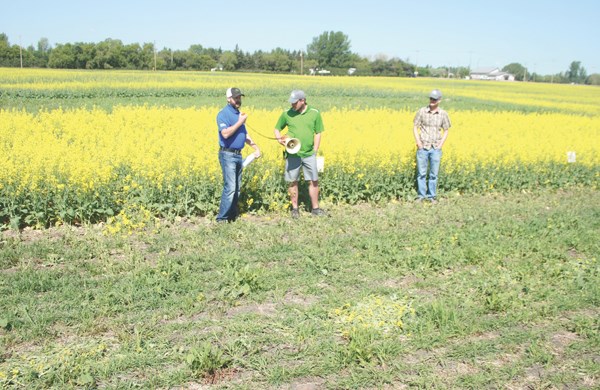The East Central Research Foundation has released three online videos focused on crop production in the local region.
The research was conducted by the East Central Research Foundation and Parkland College, which have been working collaboratively since 2013.
The videos can be found at www.ecrf.ca
The first offering focuses on Demonstrating 4R Nitrogen Principles in Canola.
Nitrogen is the most limiting nutrient in annual crop production and is often one of the most expensive crop nutrients, particularly for crops with high N requirements like canola, detailed material from the Foundation.
“Most inorganic nitrogen fertilizers contain NH4-N which is prone to volatilization when surface broadcasted … The NO3-N is not prone to volatilization but can be lost to denitrification and leaching. Single pass seeding and fertilization is fairly standard and is the best management practice for applying nitrogen. Banding nitrogen at the time of seeding minimizes loses to volatilization and maximizes nitrogen use efficiency. However, producers may apply nitrogen in the fall or post seeding to increase operational efficiencies. These timings increase the risk of nitrogen loss, particularly if it is surface applied. … This project demonstrates how to mitigate the risks associated with broadcast applications of nitrogen.”
The research concluded, “Under ideal conditions for nitrogen volatilization loss, Agrotain and Super Urea provided 18 per cent higher yields compared to straight urea when broadcasted. In fact, broadcasting Agrotain or Super Urea just prior to seeding provided the same yield as banded urea at seeding. These products are designed to provide a couple weeks of protection from volatilization losses but still need rain to move into the soil. Numerically, split applications with Agrotain or Super Urea provided somewhat higher yield than a banded application of urea at seeding. Split applications can occasionally improve nitrogen use efficiency particularly during wet seasons. However, banding the whole nitrogen requirement upfront at seeding is usually most economical.”
A second research prject looked into Soybeans-Importance of Dual Inoculation and Seeding into Warm Soil.
The overall objectives of this project were to demonstrate the importance of seeding soybeans into warm soils (>8oC) and dual inoculation (Inoculant on seed and in furrow). Specifically, the impact of seeding date and inoculant placement on soybean emergence and yield was demonstrated.
The conclusion noted “this trial set out to demonstrate the risk of seeding too early into cold soil (<8oC) and the importance of dual inoculating soybeans where there has been no history of growing soybeans. Despite seeding early on May 5th, soil temperature was well above the minimum 8oC required and the weather continued to warm without frost. As a result, soybeans seeded on this date emerged and yielded as well as the optimum seeding date on May 24th. The earlier seeded soybeans matured about 5 days earlier in the calendar which could be considered an advantage. However, it is still prudent to seed in mid to late May as this reduces the risk of crop loss to spring frost. Besides, no yield loss occurred in this study by waiting until May 24th to seed the soybeans. This Trial also set out to demonstrate the importance of dual inoculation. Dual inoculation did not produce higher yielding soybeans than single inoculation with side-banded granular inoculant. The seed applied granular inoculant performed very poorly, suggesting the treated seed may have been mistreated before we received it.”
The final research release looked at Seeding Winter Wheat into Barley Green Feed Stubble.
The objectives of the study were:
-to demonstrate the establishment of a winter wheat crop after barley was taken for green feed.
-to determine if increasing seeding rate and/or the use of seed treatment can compensate for increased winter injury at late seeding dates.
The conclusion included, “Barley taken off for green feed allowed for early seeding of winter wheat and provided adequate stubble.
In this study, the optimum seeding date was Sept 12, 2016. Seeding earlier on August 29, 2016 reduced yield significantly by 16 per cent. Seeding later on September 29, 2016 reduced yield by only four per cent and the difference was not significant. These results would support recent research from across the prairies … that the optimum seeding date has shifted about a 1 week into the fall. This is not surprising as the environment has been getting warmer and the falls more open. Producers could probably seed later into September than what has historically been recommended, as long as soil moisture conditions are adequate for seedling establishment. Though not part of the study, it was quite apparent that maturity was substantially hastened with earlier seeding date. Seed treatment was not found to improve emergence or stand establishment but was associated with higher yield, though not statistically significant. Higher yields were also associated with lower plant population which was contrary to expectations. In this study, lower plant populations may have benefitted from less inter-plant competition for limited moisture.”
— YTW Staff




